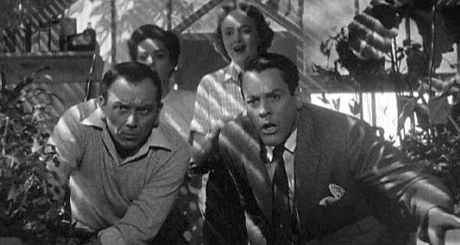Every Thursday, the Techland Screening Room digs deep in an attempt to appreciate one of the 50 most important sci-fi titles of cinema’s first century. When we’re not analyzing the films, we’re announcing the next title in the series. We welcome your thoughts, insights, grumblings and epiphanies. See our previous Screening Rooms here
It’s the sci-fi paranoia classic that spawned so many imitators and adaptations: Don Siegel’s 1956 Invasion of the Body Snatchers
[youtube=http://www.youtube.com/watch?v=L-jzblCbsuA]
What I’ve always loved about this film is the way it pivots back and forth on the paranoid edge of the McCarthy era.
There are moments when it seems to be mocking McCarthy’s paranoid rants, dismissing a world of single-minded homogeneity as something akin to hell. But then again, the movie says this alien invasion – in which bodies are swapped out with alien replicas that look and act just like normal human beings – is indeed happening, and is something worth fearing. The guy screaming from the rooftops isn’t a cook but a savior. So the climax of the film is gloriously muddled and contradictory: The rantings of a mad man inspire the worst kind of paranoia – but what if the mad man is right?
One can see the influence of Siegel’s vision – his economical use of screen time, his understated special effects, his obsession with the issue of individuality – in everything from Blade Runner to The Truman Show, to this weekend’s The Crazies (check out our review here). And popping in the Body Snatchers DVD last weekend, its kind of impressive that a 54-year-old film can still feel so fresh and suspenseful. There are moments – like that virtuoso sequence in which a silent mob amasses to receive the alien pods to infect their families – which work brilliantly. That’s because it’s all about the concept, stripped down to the essentials and allowed to play out in tight, terrifying fashion. The use of silence at several key moments is also rather brave; Siegel seems determined not to milk his material but to allow it to slowly sink in. It’s a wise strategy. (More at Techland: Check out our weekly ‘Freeze Frame’ feature, championing sci-fi’s greatest moments)
Camerawork:
Featuring performances that are notably sparse and sullen, what really energizes Siegel’s scenes is a strategy to frame the action in such a way that key moments look and feel askew.
Even when the characters are acting normally, we sense a world out of balance. I’m thinking of the scene in the greenhouse (seen in the photo above), with the extraordinary establishing camera angles that put us in the position of the alien pod. As the characters move in, we realize that our point of view is the alien point of view.
Or how about the silence leading up to Dr. Binnell and Becky’s counter-assault against the aliens in Binnell’s office? Or the wide-screen silence of the mob amassing in the town square, a crowd moving as one. Or the way the stairs loom, both down into the town square from Binnell’s office, and up to the highway, out of the valley. When Binnell and Becky sprint up those stairs, Siegel puts the camera on rollers and soars above them, looking down while rolling up. They are escaping the depths of hell. (More at Techland: The top 10 worst superhero films)
This movie looks and sounds different from the peers of its era, and I think that leads us to view the story – and its larger meanings – in a far different light.
Insider info:
Given that the movie was remade in 1993 by Abel Ferrara and 1978 by Philip Kaufman, it seems kind of remarkable that you could still point back to Siegel’s vision, made all the way back in 1956, as the superior version.
Made with less money, less prestige, and on a tighter schedule, I think all the constraints actually forced Siegel and company into developing a more focused, nuanced vision. Sometimes impediments can be a good thing. The original Invasion was written by Daniel Mainwaring, adapted from a three-part serial story that was written by Jack Finney and published in Colliers Magazine in 1954. In 1955, that serial was converted into a feature-length novel. The film project was then given the low budget of $420,000, and a rushed 19-day shooting schedule, in a bid to rush out a B-movie onto theater screens. Ironically, in only these 19 days, Siegel molded his best film. Forced to limit his special effects, straying from showing actual murders (there is only one obscured-pitchfork-into-body sequence), and thinking creatively in how to portray a town overrun with alien replicas, it’s the subtleties and misdirection that made this masterpiece.
Top Ten Moments:
19:53 – For the first 15 minutes or so, all seems well in small-town America. But then there’s the late-night call that leads to the perverse image: A corpse laying on a pool table. Or rather a not-quite-formed alien body on the pool table. What I really love here, though, is the way the exposition is conveyed while leaving absolutely everything to our imagination. The doctor walks around the body, talking about how it looks like a fake human, without Siegel ever zooming in to give us a sense of what the doctor is seeing. We never get an in-focus close-up. He describes, we take him at his word, and I think this larger concept only works precisely because we don’t have anything visual to discount. For all we know, the body does actually look pretty creepy. The movie is already asking us to fill in the void.
Also: Note the perfectly-timed cuckoo clock, trying to make you jump.


